Hitchhiker ID's
STATIONARY CRITTERS:
AIPTASIA
Aiptasia is a pest anemone that can take over your tank if you don't get rid of it. They can be brown, yellow, clear, or a few other colors. If you aren't sure if something is aiptasia, poke it with something. If it sucks into the rock, it is likely aiptasia. If it just folds up, it is probably a harmless polyp.

BUTTON POLYPS
These polyps are very common hitchhiker corals. They come in a variety of colors, but are commonly brown or green.
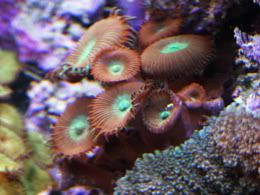
FEATHER DUSTERS
These little worms are extremely common. They are beneficial filter feeders. The worm lives in a tube and uses its feathered crown to catch particles from the water. They will retract the crown into the tube when spooked. They can be colonial, as in the photo to the right, or can be individual. They come in a variety of colors.
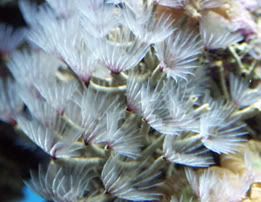
SPIONID WORMS
These worms also live in tubes, but rather than filter feeding like the dusters, they will grab larger food with their palps (the antenna-looking things). They are good scavengers.
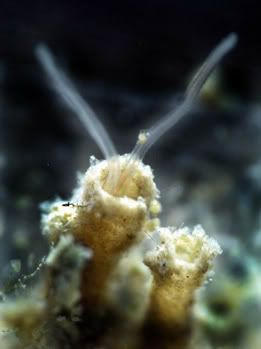
VERMITID SNAILS
The vermitid snail is yet another critter that lives in a tube. These filter feed by throwing out a mucous "net" to catch food. Most of the time, you won't see the worm but will be wondering what the "spiderwebs" in your tank are. Here's your culprit. They are harmless but can irritate corals if their nets are too close.
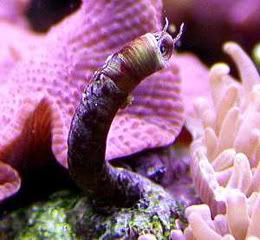
SPIRORBID WORMS
Little hard white spirals on your rock and glass causing confusion? When you look real close, do they have little feathers sticking out the end? Congrats, you got yourself some spirorbid worms. These little guys live in their calcareous shells and filter feed. They are harmless additions to your reef.
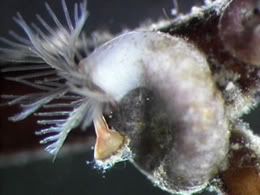
FORAMINIFERANS
These little filter feeders are very common on live rock.
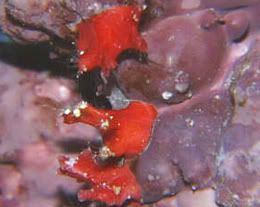
ZOANTHIDS
While some of us pay the big bucks to buy these pretty soft corals, some of you get lucky enough to get them as hitchhikers. While most hitchhiker zos are brown, colorful ones have been known to sneak in on live rock.
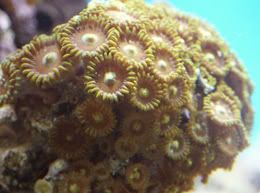
MAJANO ANEMONES
These pretty little anemones come with a bad attitude. They can quickly reproduce and will sting anything they come into contact with. Therefore, most reefers choose to eradicate them. Too bad... they really are pretty.
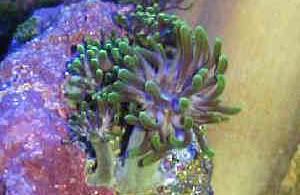
COLONIAL HYDROIDS
Hydroids come in many shapes and sizes. If you have something that sorta resembles a feather duster, but not really... look into hydroids. They can pack a mighty sting so it is good not to let them grow next to corals. They can be brown like these, white, pink, or other colors.
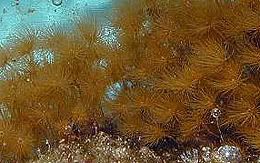
DIGITATE HYDROIDS
Digitate hydroids spread quickly and sting anything they touch, making them nasty to have in your reef tank. Too bad as it is cool to watch them bob up and down as they stretch out from the rock. I couldn't find a good pic... soooo... enjoy my drawing. LOL. They are white hairlike critters with a bulbous tip which will mostly come out at night.
SPONGES
Something soft and squishy on your rock? It's likely a sponge. They come in a wide variety of colors, shapes, and sizes.

TUNICATES
Tunicates (or sea squirts) are another filter-feeding hitchhiker. These vase-shaped critters can be clear, purple, orange, or a variety of other colors.
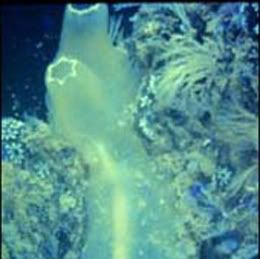
BARNACLES
If you see a little raised hole on your rock with feathers quickly going in and out the hole, you've got a barnacle. It is actually a little filter feeding shrimp-like creature that lives in the hole.

CRITTERS ON THE MOVE:
AMPHIPODS
Amphipods are little "bugs" you may see scurrying about your live rock - especially after lights out.
These little critters are beneficial scavengers and are very common.

ISOPODS
Isopods are another group of "bugs". These are mainly predatory, with the most common being the fish munching Cirolanid isopod. They are easy to spot due to their big black eyes.
Watch out... they munch people too.
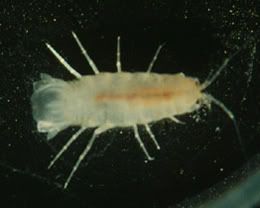
COPEPODS
Copepods, sometimes incorrectly called cocopods (I'm coo-coo for cocopods!) or copods, are often the first hitchhiker noticed in the aquarium. "What are these little white fleas on my glass?" or "I have ANTS" are commonly heard. They are a great supplemental fish food.
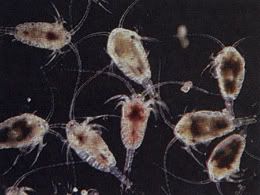
MYSID SHRIMP
Lots of people think they have baby shrimp when they see these little fellas scooting about (usually at night).
They dart about quickly and are harmless. They also make good extra fish food. I've seen both red and white/clear ones in my tank.
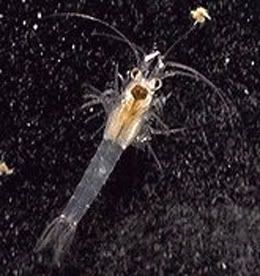
BRISTLEWORMS
"I have a centipede in my tank!"
Most bristleworms found in our aquariums are good guys. They scavenge leftover food and help stir the sandbed. Put some pellets in your tank at night and watch the fun with a red flashlight. Wooo-creepy!
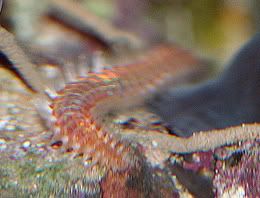
PEANUT WORMS
Your watching your tank at night and the light hits a long striped worm. It retracts back into the rock quickly. What IS that thing?! It's ok, just a friendly nocturnal peanut worm out for a bite.

SPAGHETTI AND HAIR WORMS
You may have some odd hairs squirming about on your sandbed. They may be red, green, brown, or white. They grab food too. Looks like you have hair worms (commonly called spaghetti worms).
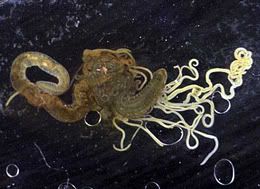
FLATWORMS
Flatworms come in many shapes and sizes but there are two types that are very common in aquaria. The first is a small clear flatworm. Imagine a blob of clear jello with a forked tail. These type are usually harmless.
The other ones, the red ones, can reach plague proportions as they reproduce rapidly and smother corals. Products like "Flatworm Exit" help eradicate them.
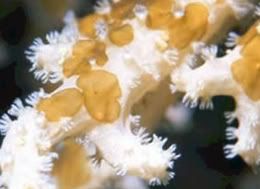
MANTIS SHRIMP
These guys are really common hitchhikers on TBS and Florida live rock. You may see him at night, or he may be hiding but you hear his "CLICK CLICK" as he digs in the rock (this could also be a pistol shrimp). As cool as they are, mantis are bad news in your tank. They are predatory and will eat anything they can catch, including your inverts and fish. If you have an extra tank, they are great for a species tank. If you don't, don't kill him. There are lots of people looking for them.

LIMPETS
Limpets are little pointy-shelled snail-like creatures. You may find them crawling along your glass or rock. I have a ton of them in my sump. These guys are for the most part good guys but there are some bad types.
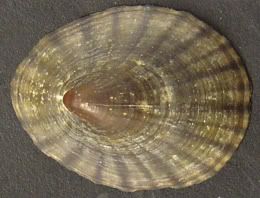
SHIELD LIMPETS
Then there are some very different looking critters that are also limpets. The shield limpets are fleshy black slugs with a white shell hidden in their skin.
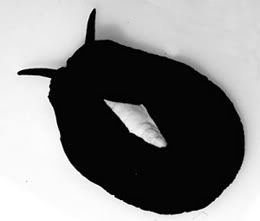
CHITONS
Chitons are new to me as I have never had one. But if you find a potato bug in your reef, you have one. They may graze on your coralline algae or diatoms in your tank.
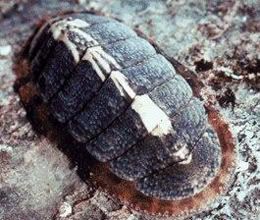
ASTERINA STARS
You may see little oddly shaped white starfish crawling around on your glass. These are asterina stars. They will split and multiply in your tank. MOST asterinas in our tanks are good guys, but there are some types that munch on coral. Watch them... if they are always on your coral, be wary. If they are cruising your glass, they are probably algae grazers.
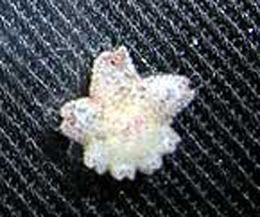
MINI BRITTLE STARS
Normally you won't see these guys. You'll just notice a small striped or white arm waving out from a hole in the rock. This is their normal behavior and they rarely come out from the rock. They are harmless in the tank and will reproduce if they have food.
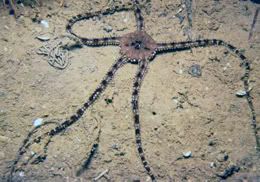
COLLONISTA SNAILS
These small algae grazers are nocturnal. You'll notice little white spots on your glass, which upon closer inspection, are tiny checkerboard snails. They will reproduce well and are beneficial. They stay small. The largest one I've seen is about 1/4" across.
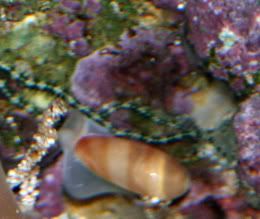
PEPPERMINT SNAILS
These smooth, shiny-shelled guys are also nocturnal but they aren't algae grazers.
They will appear out of nowhere to munch on a dead snail. Creepy, yes, but harmless.

ASTRAEA SNAILS
This is one type I have in my tank, but there are LOTS of them. They are good guys and algae munchers.
Here are Dr. Shimek's snail articles where you can browse different models of snails.

STOMATELLA VARIA
You may think it is a slug, but take a closer look and you'll see its flat fingernail-like shell. These guys will breed like crazy and are fantastic algae consumers. They also have a lizard-like characteristic - they can drop their "tails" if attacked. First time I picked one up and it came apart, it freaked me out!

COLUMBELLID SNAILS
Sold by IPSF as "Strombus grazers", these are easily my favorite snails. They breed like crazy, eat constantly, and are hardy. If you can get your hands on these guys, I highly recommend them.

PYRAMID SNAILS
If you see little white snails hitching a ride on your turbo snail, astraea, or clam, you may have these nasty parasites. They suck the blood of their host until dead! If you have them, pick them off their hosts until gone. They are species-specific and will only go after the same type snail or clam (clam pyramids won't attack snails and vice-versa).
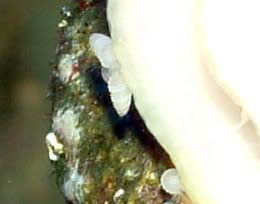
SUNDIAL SNAILS
The "trap door" covering their opening is the giveaway sign that you are dealing with a sundial. These critters are zoanthid eaters. The only way to eradicate them safely is manual removal.

AEOLID NUDIBRANCHS
There are lots of aeolids (including the aiptasia-eating berghia - a good guy to have!) but the most common one for us is this guy - a zoanthid predator! They are a pain to get rid of but will mow through your zos if you don't.
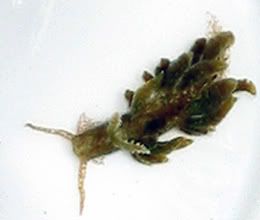
ACRO CRABS
These little "masked" smooth crabs are common hitchhikers on acropora. They are cute and cause no harm to the coral in my experience. They will wave their claws to grab food from the current and will protect their acro from other inhabitants who'd love to crawl on it.
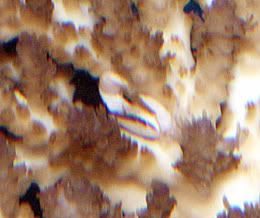
PORCELAIN CRABS
These cute crabs are distinguished by their 3 pair of walking legs and their "fans". They catch food particles and transfer to their mouth. They come in a variety of colors and patterns and are common on TBS and Florida rock.
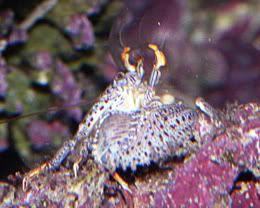
HAIRY CRABS
Their are many types of hairy crabs. In general, most are bad and opportunistic feeders (other than mithrax which have a smooth body, hairy legs, and "scoop" shaped claws). I am against killing any creatures whenever possible so if you find one of these guys, give him a home in your sump or with a friend or your LFS.

SEA SPIDERS
ACK! A spider in my tank! Yep, and they are bad news too. Get that sucker out of there.

URCHINS
Most urchins we get are mainly harmless. This one goes back and forth on my back wall munching coralline algae. He hasn't made a dent in it either.
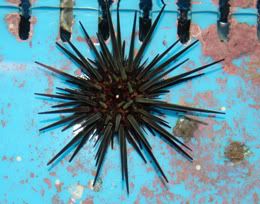
ALGAES AND GROWTHS:
VALONIA AKA BUBBLE ALGAE
These shiny bubbles can appear green or black in your reef. Usually when you notice it, it will be a single gleaming sphere. The bad thing about valonia is that it spreads rapidly. Some people have success getting rid of them with emerald crabs. I have found that just carefully removing them with tweezers works.
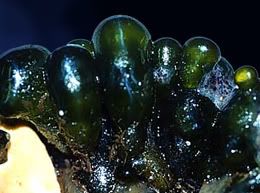
CORALLINE ALGAE
In a new reef tank, your first experience with coralline will probably be on your live rock. You'll see some hard purple, green, or red (or maybe even another color) growth. You may also see some purple dots begin to grow on your glass or on a powerhead. Coralline uses light and calcium to grow.

HAIR ALGAE
This fine quick-growing algae can take over fast. While my tang likes to eat it, some don't. And it can be a pain to find a way to eradicate it.
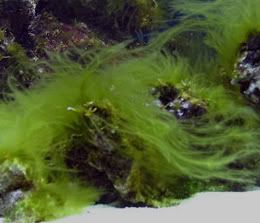
BRYOPSIS
Another "pest" algae, bryopsis can grow out of control. Unlike hair algae, there aren't a lot of critters we keep that enjoy eating it.
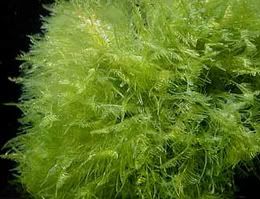
CHAETOMORPHA
Also known as spaghetti algae, chaeto is a wiry algae that grows like a big clump of Brillo pad. It is one of the most highly desirable macro alga for use in refugiums.
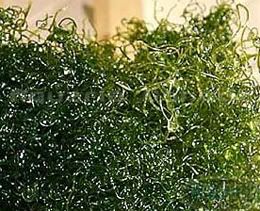
CAULERPA
There are many, many types, but the photo is is a common variety found in reef tanks.
It grows along, forming new roots and digging into rock as it goes like bermuda grass. It can be hard to remove from your display once it builds a good root system.
Some people use it as nutrient export in a fuge or sump, but there are good and bad sides to caulerpa.

GRAPE CAULERPA
A particularly annoying type of macro algae. There is an aquarium store near me that has this algae spread throughout all their tanks. Boy is it ugly.

HALIMEDA.
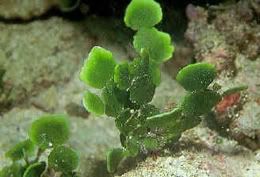
DIATOMS

DINOFLAGELLATES

CYANOBACTERIA
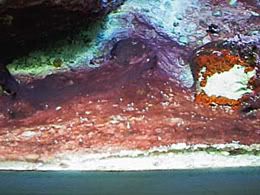
Taken From: http://www.xtalworld.com/Aquarium/hitchfaq.htm
STATIONARY CRITTERS:
AIPTASIA
Aiptasia is a pest anemone that can take over your tank if you don't get rid of it. They can be brown, yellow, clear, or a few other colors. If you aren't sure if something is aiptasia, poke it with something. If it sucks into the rock, it is likely aiptasia. If it just folds up, it is probably a harmless polyp.

BUTTON POLYPS
These polyps are very common hitchhiker corals. They come in a variety of colors, but are commonly brown or green.

FEATHER DUSTERS
These little worms are extremely common. They are beneficial filter feeders. The worm lives in a tube and uses its feathered crown to catch particles from the water. They will retract the crown into the tube when spooked. They can be colonial, as in the photo to the right, or can be individual. They come in a variety of colors.

SPIONID WORMS
These worms also live in tubes, but rather than filter feeding like the dusters, they will grab larger food with their palps (the antenna-looking things). They are good scavengers.

VERMITID SNAILS
The vermitid snail is yet another critter that lives in a tube. These filter feed by throwing out a mucous "net" to catch food. Most of the time, you won't see the worm but will be wondering what the "spiderwebs" in your tank are. Here's your culprit. They are harmless but can irritate corals if their nets are too close.

SPIRORBID WORMS
Little hard white spirals on your rock and glass causing confusion? When you look real close, do they have little feathers sticking out the end? Congrats, you got yourself some spirorbid worms. These little guys live in their calcareous shells and filter feed. They are harmless additions to your reef.

FORAMINIFERANS
These little filter feeders are very common on live rock.

ZOANTHIDS
While some of us pay the big bucks to buy these pretty soft corals, some of you get lucky enough to get them as hitchhikers. While most hitchhiker zos are brown, colorful ones have been known to sneak in on live rock.

MAJANO ANEMONES
These pretty little anemones come with a bad attitude. They can quickly reproduce and will sting anything they come into contact with. Therefore, most reefers choose to eradicate them. Too bad... they really are pretty.

COLONIAL HYDROIDS
Hydroids come in many shapes and sizes. If you have something that sorta resembles a feather duster, but not really... look into hydroids. They can pack a mighty sting so it is good not to let them grow next to corals. They can be brown like these, white, pink, or other colors.

DIGITATE HYDROIDS
Digitate hydroids spread quickly and sting anything they touch, making them nasty to have in your reef tank. Too bad as it is cool to watch them bob up and down as they stretch out from the rock. I couldn't find a good pic... soooo... enjoy my drawing. LOL. They are white hairlike critters with a bulbous tip which will mostly come out at night.
SPONGES
Something soft and squishy on your rock? It's likely a sponge. They come in a wide variety of colors, shapes, and sizes.

TUNICATES
Tunicates (or sea squirts) are another filter-feeding hitchhiker. These vase-shaped critters can be clear, purple, orange, or a variety of other colors.

BARNACLES
If you see a little raised hole on your rock with feathers quickly going in and out the hole, you've got a barnacle. It is actually a little filter feeding shrimp-like creature that lives in the hole.

CRITTERS ON THE MOVE:
AMPHIPODS
Amphipods are little "bugs" you may see scurrying about your live rock - especially after lights out.
These little critters are beneficial scavengers and are very common.

ISOPODS
Isopods are another group of "bugs". These are mainly predatory, with the most common being the fish munching Cirolanid isopod. They are easy to spot due to their big black eyes.
Watch out... they munch people too.

COPEPODS
Copepods, sometimes incorrectly called cocopods (I'm coo-coo for cocopods!) or copods, are often the first hitchhiker noticed in the aquarium. "What are these little white fleas on my glass?" or "I have ANTS" are commonly heard. They are a great supplemental fish food.

MYSID SHRIMP
Lots of people think they have baby shrimp when they see these little fellas scooting about (usually at night).
They dart about quickly and are harmless. They also make good extra fish food. I've seen both red and white/clear ones in my tank.

BRISTLEWORMS
"I have a centipede in my tank!"
Most bristleworms found in our aquariums are good guys. They scavenge leftover food and help stir the sandbed. Put some pellets in your tank at night and watch the fun with a red flashlight. Wooo-creepy!

PEANUT WORMS
Your watching your tank at night and the light hits a long striped worm. It retracts back into the rock quickly. What IS that thing?! It's ok, just a friendly nocturnal peanut worm out for a bite.

SPAGHETTI AND HAIR WORMS
You may have some odd hairs squirming about on your sandbed. They may be red, green, brown, or white. They grab food too. Looks like you have hair worms (commonly called spaghetti worms).

FLATWORMS
Flatworms come in many shapes and sizes but there are two types that are very common in aquaria. The first is a small clear flatworm. Imagine a blob of clear jello with a forked tail. These type are usually harmless.
The other ones, the red ones, can reach plague proportions as they reproduce rapidly and smother corals. Products like "Flatworm Exit" help eradicate them.

MANTIS SHRIMP
These guys are really common hitchhikers on TBS and Florida live rock. You may see him at night, or he may be hiding but you hear his "CLICK CLICK" as he digs in the rock (this could also be a pistol shrimp). As cool as they are, mantis are bad news in your tank. They are predatory and will eat anything they can catch, including your inverts and fish. If you have an extra tank, they are great for a species tank. If you don't, don't kill him. There are lots of people looking for them.

LIMPETS
Limpets are little pointy-shelled snail-like creatures. You may find them crawling along your glass or rock. I have a ton of them in my sump. These guys are for the most part good guys but there are some bad types.

SHIELD LIMPETS
Then there are some very different looking critters that are also limpets. The shield limpets are fleshy black slugs with a white shell hidden in their skin.

CHITONS
Chitons are new to me as I have never had one. But if you find a potato bug in your reef, you have one. They may graze on your coralline algae or diatoms in your tank.

ASTERINA STARS
You may see little oddly shaped white starfish crawling around on your glass. These are asterina stars. They will split and multiply in your tank. MOST asterinas in our tanks are good guys, but there are some types that munch on coral. Watch them... if they are always on your coral, be wary. If they are cruising your glass, they are probably algae grazers.

MINI BRITTLE STARS
Normally you won't see these guys. You'll just notice a small striped or white arm waving out from a hole in the rock. This is their normal behavior and they rarely come out from the rock. They are harmless in the tank and will reproduce if they have food.

COLLONISTA SNAILS
These small algae grazers are nocturnal. You'll notice little white spots on your glass, which upon closer inspection, are tiny checkerboard snails. They will reproduce well and are beneficial. They stay small. The largest one I've seen is about 1/4" across.

PEPPERMINT SNAILS
These smooth, shiny-shelled guys are also nocturnal but they aren't algae grazers.
They will appear out of nowhere to munch on a dead snail. Creepy, yes, but harmless.

ASTRAEA SNAILS
This is one type I have in my tank, but there are LOTS of them. They are good guys and algae munchers.
Here are Dr. Shimek's snail articles where you can browse different models of snails.

STOMATELLA VARIA
You may think it is a slug, but take a closer look and you'll see its flat fingernail-like shell. These guys will breed like crazy and are fantastic algae consumers. They also have a lizard-like characteristic - they can drop their "tails" if attacked. First time I picked one up and it came apart, it freaked me out!

COLUMBELLID SNAILS
Sold by IPSF as "Strombus grazers", these are easily my favorite snails. They breed like crazy, eat constantly, and are hardy. If you can get your hands on these guys, I highly recommend them.

PYRAMID SNAILS
If you see little white snails hitching a ride on your turbo snail, astraea, or clam, you may have these nasty parasites. They suck the blood of their host until dead! If you have them, pick them off their hosts until gone. They are species-specific and will only go after the same type snail or clam (clam pyramids won't attack snails and vice-versa).

SUNDIAL SNAILS
The "trap door" covering their opening is the giveaway sign that you are dealing with a sundial. These critters are zoanthid eaters. The only way to eradicate them safely is manual removal.

AEOLID NUDIBRANCHS
There are lots of aeolids (including the aiptasia-eating berghia - a good guy to have!) but the most common one for us is this guy - a zoanthid predator! They are a pain to get rid of but will mow through your zos if you don't.

ACRO CRABS
These little "masked" smooth crabs are common hitchhikers on acropora. They are cute and cause no harm to the coral in my experience. They will wave their claws to grab food from the current and will protect their acro from other inhabitants who'd love to crawl on it.

PORCELAIN CRABS
These cute crabs are distinguished by their 3 pair of walking legs and their "fans". They catch food particles and transfer to their mouth. They come in a variety of colors and patterns and are common on TBS and Florida rock.

HAIRY CRABS
Their are many types of hairy crabs. In general, most are bad and opportunistic feeders (other than mithrax which have a smooth body, hairy legs, and "scoop" shaped claws). I am against killing any creatures whenever possible so if you find one of these guys, give him a home in your sump or with a friend or your LFS.

SEA SPIDERS
ACK! A spider in my tank! Yep, and they are bad news too. Get that sucker out of there.

URCHINS
Most urchins we get are mainly harmless. This one goes back and forth on my back wall munching coralline algae. He hasn't made a dent in it either.

ALGAES AND GROWTHS:
VALONIA AKA BUBBLE ALGAE
These shiny bubbles can appear green or black in your reef. Usually when you notice it, it will be a single gleaming sphere. The bad thing about valonia is that it spreads rapidly. Some people have success getting rid of them with emerald crabs. I have found that just carefully removing them with tweezers works.

CORALLINE ALGAE
In a new reef tank, your first experience with coralline will probably be on your live rock. You'll see some hard purple, green, or red (or maybe even another color) growth. You may also see some purple dots begin to grow on your glass or on a powerhead. Coralline uses light and calcium to grow.

HAIR ALGAE
This fine quick-growing algae can take over fast. While my tang likes to eat it, some don't. And it can be a pain to find a way to eradicate it.

BRYOPSIS
Another "pest" algae, bryopsis can grow out of control. Unlike hair algae, there aren't a lot of critters we keep that enjoy eating it.

CHAETOMORPHA
Also known as spaghetti algae, chaeto is a wiry algae that grows like a big clump of Brillo pad. It is one of the most highly desirable macro alga for use in refugiums.

CAULERPA
There are many, many types, but the photo is is a common variety found in reef tanks.
It grows along, forming new roots and digging into rock as it goes like bermuda grass. It can be hard to remove from your display once it builds a good root system.
Some people use it as nutrient export in a fuge or sump, but there are good and bad sides to caulerpa.

GRAPE CAULERPA
A particularly annoying type of macro algae. There is an aquarium store near me that has this algae spread throughout all their tanks. Boy is it ugly.

HALIMEDA.

DIATOMS

DINOFLAGELLATES

CYANOBACTERIA

Taken From: http://www.xtalworld.com/Aquarium/hitchfaq.htm
